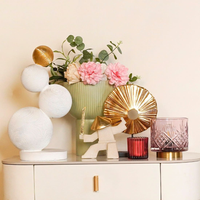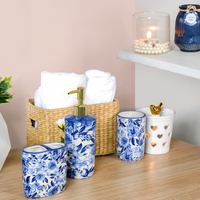Feng Shui… a world where chi flows more smoothly than champagne.
There’s something about this centering ancient Chinese philosophy that always draws people back to it. Whether it’s wanting a fresh start at the beginning of the year or feeling your space or the fascination that surrounds the topic, Feng Shui prompts you to gain a deeper understanding of the philosophy. Perhaps what captivates us most is the idea that by harmonizing our environment, we can unlock hidden potentials and invite prosperity into every corner of our existence. Well, whatever it may be, the allure is undeniable.

But, through it all, certain questions commonly arise about Feng Shui. For example, what is it? How do we properly implement it into our space? And, most importantly, does rearranging your furniture really bring about good fortune or is it all just a case of stylish superstition?
Well, beautiful readers, hold onto your sage smudge sticks, because we are about to dish all the secrets to spatial harmony.
Understanding Feng Shui
Let’s start with the basics. What is Feng Shui?
It’s an ancient Chinese philosophy that originated 6000 years ago to explain how the placement of objects in our space, whether it’s furniture or home decor, can affect the flow of energy, or chi, in our home, and thus, by proxy our personal lives as well. Think of it as a similar concept of Vastu in Hinduism.
Furthermore, Feng Shui states that our surroundings go far beyond having the ability to affect our materialistic comfort. Rather, it can affect the level of success we attain in our lives. The quality of relationships we share, both personally and professionally. And, above all, our physical and mental health.
Five:
The notion of Feng Shui is based on five elements of nature that work together to be in balance with one another. Earth, wood, fire, water, and metal. Each element is associated with specific colours and shapes to be used within the design of our homes to improve the qualities and areas they are associated with.
Let’s take a closer look, shall we?
Earth:
Grounding and nurturing, the Earth element fosters stability, support, and nourishment.
There, are a few different ways you can incorporate ‘Earth” into your space. Earthy colour palettes such as soft sandy beiges or deep forest greens capture the hues of nature's natural landscapes. Square home decor like decor objects, vases, and photo frames made from natural materials like ceramic, stone, or clay, ground your space with organic textures and shapes.
Another possibility is wall art that celebrates the beauty of the natural world. Whether it's a scenic landscape painting, a botanical print, or a sculpture inspired by organic forms, let nature be your muse as you curate a gallery of earthy masterpieces.
Wood:
Representing growth, vitality, and flexibility, the Wood element is associated with new beginnings and expansion.
Incorporate Wood energy into your space with wooden furniture, houseplants, or decor made from natural fibres like bamboo or rattan. Vertical lines and green colour schemes also evoke the essence of Wood.
Fire:
Fire symbolizes passion, energy, and transformation. Introduce Fire energy into your home with candles, fireplace features, or vibrant red accents.
Furthermore, triangular shapes, pointed objects, and bold patterns can stimulate the dynamic energy of Fire.
Metal:
Representing clarity, precision, and strength, the Metal element brings focus, organization, and efficiency to your environment.
Metallic accents like photo frames, stainless steel cutlery, bar tools, or even kitchenware, or home decor featuring circular shapes or metallic colours can be included. White and pastel hues also evoke the crisp, clean energy of Metal.
Water:
Flowing and adaptable, the Water element symbolizes abundance, intuition, and emotional depth.
You can invite the chi of water into your surroundings with water elements like fountains, ponds, aquariums, mirrors to reflect light and energy, and shades of blue and black that mimic the ocean.
The Commanding Position:
No, it’s not what you think.
The commanding position in Feng Shui is another fundamental principle that Feng Shui heavily relies on. It involves three daily household items that represent the most significant aspects of our lives. The bed, which represents us as a person. The stove symbolizes our wealth and resources. And finally, the desk we most often use, which represents our careers and the path we take in life.
According to Feng Shui, for these three objects to be in the optimal commanding position, they must be in a position where we can see the door without being directly in front of it. Whether you are relaxing on your bed, warming a teapot on the stove, or working at your desk, you must be able to see the door. The idea is that by having a good view of anyone or anything coming through the door, you instantly feel more at ease subconsciously, as you’ll always be prepared for what is coming your way, be it threats or opportunities.
Important Spaces To Implement Feng Shui:
Although you should feng shui your entire house, four rooms are non-negotiable.
The Entrance:
Often dubbed as the “Mouth of Chi” the entrance is where energy enters into our space. Just as food enters our mouths to provide the nourishment and energy essential to our physical well-being, the same concept applies to the entrance of our homes with regard to feng shui. Therefore, if left unused, it means no energy is entering the space. Therefore, even the smallest elements like a polished door handle to an illuminated entrance with elegant light fixtures can greatly affect our chi.
The Bedroom:
The bedroom is a space where we often unwind, relax, and refresh ourselves. Therefore, it’s important to ensure your bed is in the optimal position to allow such rejuvenation to take place. Firstly, your bed must be in the command position. Second, it must never be placed under a window, as maximum back support is key, and only solid walls can provide this. And finally, avoid placing the bed under a face, chandelier, or light fixture as this can promote a sense of physical pressure.
Furthermore, you must be careful about what you introduce into this space. The bedroom is an oasis, Therefore, gym equipment, computers, and even irons are all work-related objects, and as a result, must be left outside of the bedroom.
The Kitchen:
The heart of a home, the kitchen provides nourishment and nurturing to space. But in the world of Feng Shui, it represents our wealth, good fortune, and resources available to us throughout our lives.

Aside from the stove being in a command position, one of the most important tips is being mindful of how different elements are placed. For example, water, or a sink, should not be placed next to fire, or the stove. This is because in Feng Shui, water as the water symbolically extinguishes the fire, therefore, you are limiting your wealth and resources.
The Study Room:
The home office is where your brain is stimulated, ideas are born, and dreams take flight. It's the sanctuary where productivity meets creativity, and the magic truly happens. With every click of the keyboard and stroke of the pen, your thoughts materialize into reality, shaping the world around you. Therefore, it’s only natural that it’s a non-negotiable room where you must do Feng Shui.
Although the desk must be in command position, it must also be in the furthest spot away from the door, as this is considered the “protected” position, ensuring productivity is at its pinnacle.
Furthermore, objects to your left must invite the most active energy into the space. You see, the left is associated with male energy, or the yang energy, and influences material opportunities, wealth, and prosperity. Therefore, a desk should ideally be placed by a window.
On the other hand, the right side symbolizes the yin energy or female energy. As a result, it must invite quiet energy to balance the space out. Therefore, furniture pieces like a sofa or armchair should be placed on the right-hand side of the desk.






















